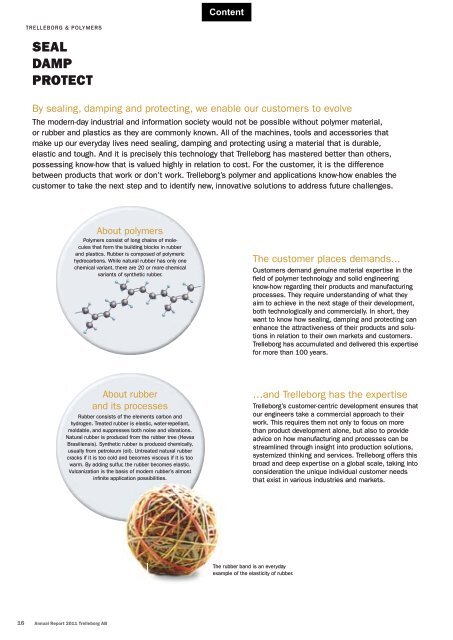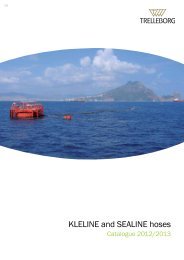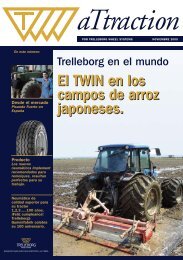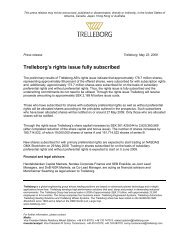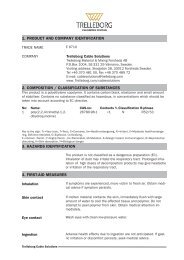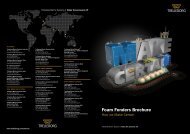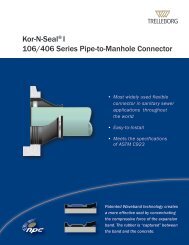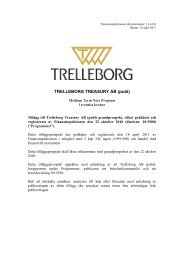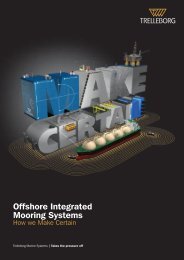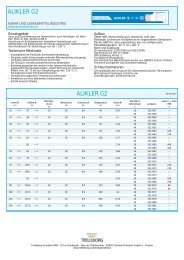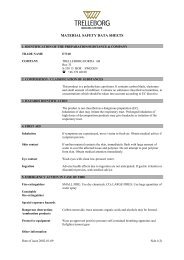Annual report 2011 - Trelleborg
Annual report 2011 - Trelleborg
Annual report 2011 - Trelleborg
Create successful ePaper yourself
Turn your PDF publications into a flip-book with our unique Google optimized e-Paper software.
TRELLEBORG & POLYMERS<br />
SEAL<br />
DAMP<br />
PROTECT<br />
By sealing, damping and protecting, we enable our customers to evolve<br />
The modern-day industrial and information society would not be possible without polymer material,<br />
or rubber and plastics as they are commonly known. All of the machines, tools and accessories that<br />
make up our everyday lives need sealing, damping and protecting using a material that is durable,<br />
elastic and tough. And it is precisely this technology that <strong>Trelleborg</strong> has mastered better than others,<br />
possessing know-how that is valued highly in relation to cost. For the customer, it is the difference<br />
between products that work or don’t work. <strong>Trelleborg</strong>’s polymer and applications know-how enables the<br />
customer to take the next step and to identify new, innovative solutions to address future challenges.<br />
16 <strong>Annual</strong> Report <strong>2011</strong> <strong>Trelleborg</strong> AB<br />
About polymers<br />
Polymers consist of long chains of molecules<br />
that form the building blocks in rubber<br />
and plastics. Rubber is composed of polymeric<br />
hydrocarbons. While natural rubber has only one<br />
chemical variant, there are 20 or more chemical<br />
variants of synthetic rubber.<br />
About rubber<br />
and its processes<br />
Rubber consists of the elements carbon and<br />
hydrogen. Treated rubber is elastic, water-repellant,<br />
moldable, and suppresses both noise and vibrations.<br />
Natural rubber is produced from the rubber tree (Hevea<br />
Brasiliensis). Synthetic rubber is produced chemically,<br />
usually from petroleum (oil). Untreated natural rubber<br />
cracks if it is too cold and becomes viscous if it is too<br />
warm. By adding sulfur, the rubber becomes elastic.<br />
Vulcanization is the basis of modern rubber’s almost<br />
infi nite application ppossibilities.<br />
The customer places demands...<br />
Customers demand genuine material expertise in the<br />
fi eld of polymer technology and solid engineering<br />
know-how regarding their products and manufacturing<br />
processes. They require understanding of what they<br />
aim to achieve in the next stage of their development,<br />
both technologically and commercially. In short, they<br />
want to know how sealing, damping and protecting can<br />
enhance the attractiveness of their products and solutions<br />
in relation to their own markets and customers.<br />
<strong>Trelleborg</strong> has accumulated and delivered this expertise<br />
for more than 100 years.<br />
…and <strong>Trelleborg</strong> has the expertise<br />
<strong>Trelleborg</strong>’s customer-centric development ensures that<br />
our engineers take a commercial approach to their<br />
work. This requires them not only to focus on more<br />
than product development alone, but also to provide<br />
advice on how manufacturing and processes can be<br />
streamlined through insight into production solutions,<br />
systemized thinking and services. <strong>Trelleborg</strong> offers this<br />
broad and deep expertise on a global scale, taking into<br />
consideration the unique individual customer needs<br />
that exist in various industries and markets.<br />
The rubber band is an everyday<br />
example of the elasticity of rubber.


